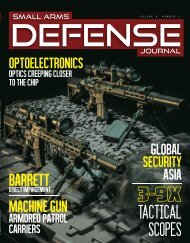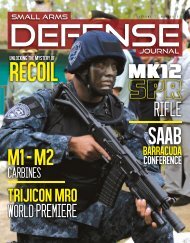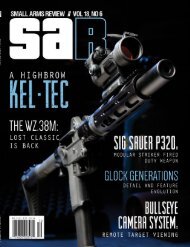Create successful ePaper yourself
Turn your PDF publications into a flip-book with our unique Google optimized e-Paper software.
Dave Walls posing with the rifles he brought into the<br />
precision rifle community. The L96 (top) was Accuracy<br />
International’s first major contract and brought<br />
them into legitimacy. Although the rifle has substantially<br />
evolved since this first model, many of the features<br />
that were introduced in it remain the same such<br />
as the flat bottomed receiver, shape of the bolt, and<br />
thumbhole stock (available as an option on the AICS<br />
stocks). If the L96 brought the company legitimacy,<br />
then the Arctic Warfare (middle) brought it onto a<br />
world stage by winning a contract with the Swedish<br />
military. A few changes from the L96 are a lighter<br />
chassis, folding stock, contoured butt stock, and an<br />
improved bolt. The rifle below the AW (bottom) is the<br />
AE, which didn’t fare so well, being a lower cost rifle<br />
intended for police forces in the United States.<br />
shot. Malcolm said, “I’ll get you any gun<br />
you want, if you want to have a look and<br />
see if you can get any ideas from them.”<br />
He produced about 8 rifles and I discarded<br />
about 5 of them.<br />
<strong>SADJ</strong>: What ended up as the design of<br />
the magazine?<br />
Dave: Initially I settled for a Springfield<br />
magazine, basically because it was easier<br />
to fit in my gun than any of the others. I<br />
designed the magazine port in the underside<br />
of the action body around this magazine<br />
and it seemed to work quite well.<br />
Then Malcolm submitted this weapon to<br />
both the SBS and the SAS who were also<br />
interested. After the trails on these weapons<br />
were made an order was placed for 42<br />
rifles with aluminum chassis’ with a wood<br />
covering this was the predecessor to the<br />
later developed L96A1. Then we found a<br />
company that would make honeycomb-like<br />
stocks with a hard surface on the outside.<br />
<strong>SADJ</strong>: Where are those 42 original<br />
rifles today?<br />
Dave: Well some went to Hereford and<br />
some went to Dorset; I don’t know where<br />
they went from there. They might even still<br />
be there. Following on from this after the<br />
Falklands War the British infantry got interested<br />
in tendering for a new sniper rifle.<br />
This contract was for 1,212 rifles plus<br />
spares. We decided to enter the tender, but<br />
we didn’t think we’d ever win, but we could<br />
use the trail to obtain feedback on our<br />
product. At this time we were still working<br />
from a garden shed and we didn’t think the<br />
British Army would be interested in our<br />
rifle. We literally went ahead, submitted<br />
Olympic Gold medalist and world champion.<br />
After the match we all went to a barbecue<br />
where he was told about the replica<br />
Colt pistols that we had made, he was very<br />
interested and asked if he could see them.<br />
I lived less than a mile from the barbecue<br />
so we left and drove to my house. After<br />
seeing the pistols he said to me, “You’ve<br />
got the potential to design your own rifle.”<br />
To which we replied that we already had<br />
been designing our own action for a target<br />
rifle. Malcolm wanted to see the action and<br />
after looking at it he asked us if we would<br />
make him one, which we agreed to do. He<br />
later shot a new 300 meter world record.<br />
Malcolm at that time was the owner of a<br />
gun shop in Portsmouth. Dave Caig and I<br />
formed a mutual agreement to do repairs<br />
and re-barreling for him, as we did for<br />
several other gun shops. Trade was building<br />
up along with our reputation. Soon<br />
we were taking in repairs and tuning of<br />
rifles from top international competitors<br />
from all over the world. Malcolm was approached<br />
by a contact in the British Army<br />
about a tender (contract) for a new sniper<br />
rifle and he came along to discuss with us<br />
the possibility of putting a magazine in one<br />
of our target rifles. We had never made a<br />
magazine fed rifle before as all my interest<br />
was in target shooting which was single<br />
Today, unlike in the 1990s, the company is not in any sort of debt,<br />
and all the machinery in the factory is paid off in full. From a meager<br />
2 CNC machines in the late 90s, one of which wasn’t even<br />
working, the company now boosts over 30 of them in addition to<br />
various other modern machine stations.<br />
SADEFENSEJOURNAL.COM 103









